Hepatocyte Nuclear Factor 4α (HNF4α) Plays a Controlling Role in Expression of the Retinoic Acid Receptor β (RARβ) Gene in Hepatocytes
Abstract
1. Introduction
2. Results
2.1. Loss of HNF4α Induces Expression of the RARβ Gene in Mouse Liver
2.2. Overexpression of HNF4α Up-Regulates Promoter Activity of the Human RARβ Gene in HepG2 Cells Treated with RA
2.3. HNF4α Response Element(s) May Reside within the RARE Sites in the Promoter of the RARβ Gene
2.4. At Least Two RARE Sites Are Present in the Proximate Region of the RARβ2 Promoter
2.5. Retinoic Acid but Not Linoleic Acid Induces the Transcriptional Activation of HNF4α toward the RARβ Promoter
2.6. Mutation of the Amino Acid Residues Essential for Fatty Acid Binding in the Ligand Binding Domain of HNF4α Results in Suppression of Its Transcriptional Activation
3. Discussion
4. Materials and Methods
4.1. Materials
4.2. Animal Experiment and RNA Analysis
4.3. Analysis of RAR Gene Expression in Cultured Cells
4.4. Cloning and Preparation of Vector Constructs
4.5. Transfection and Luciferase Assay Analysis
4.6. Statistical Analysis
Supplementary Materials
Author Contributions
Funding
Institutional Review Board Statement
Informed Consent Statement
Data Availability Statement
Conflicts of Interest
Abbreviations
References
- Carrier, M.; Rochette-Egly, C. Control of gene expression by nuclear retinoic acid receptors. In The Retinoids; John Wiley & Sons, Inc.: Hoboken, NJ, USA, 2015; pp. 91–116. [Google Scholar]
- Peluso-Iltis, C.; Osz, J.; Rochel, N. DNA recognition by retinoic acid nuclear receptors. Methods Enzymol. 2020, 637, 235–260. [Google Scholar] [PubMed]
- Pohl, E.; Tomlinson CW, E. Classical pathways of gene regulation by retinoids. Methods Enzymol. 2020, 637, 151–173. [Google Scholar] [PubMed]
- Urban, S.; Ye, T.; Davidson, I. How the RAR–RXR heterodimer recognizes the genome. In The Retinoids; John Wiley & Sons, Inc.: Hoboken, NJ, USA, 2015; pp. 151–163. [Google Scholar]
- Altucci, L.; Gronemeyer, H. Nuclear receptors in cell life and death. Trends Endocrin. Metab. 2001, 12, 460–468. [Google Scholar] [CrossRef] [PubMed]
- Balmer, J.E.; Blomhoff, R. Gene expression regulation by retinoic acid. J. Lipid Res. 2002, 43, 1773–1808. [Google Scholar] [CrossRef] [PubMed]
- Sucov, H.M.; Murakami, K.K.; Evans, R.M. Characterization of an autoregulated response element in the mouse retinoic acid receptor type b gene. Proc. Natl. Acad. Sci. USA 1990, 87, 5392–5396. [Google Scholar] [CrossRef]
- de Thé, H.; Vivanco-Ruiz, M.M.; Tiollais, P.; Stunnenberg, H.; Dejean, A. Identification of a retinoic acid responsive element in the retinoic acid receptor beta gene. Nature 1990, 343, 177–180. [Google Scholar] [CrossRef]
- Haq, R.; Pfahl, M.; Chytil, F. Retinoic acid affects the expression of nuclear retinoic acid receptors in tissues of retinol-deficient. Proc. Natl. Acad. Sci. USA 1991, 88, 8272–8276. [Google Scholar] [CrossRef]
- Kato, S.; Mano, H.; Kumazawa, T.; Yoshizawa, Y.; Kojima, R.; Masushige, S. Effect of retinoid status on alpha, beta and gamma retinoic acid receptor mRNA levels in various rat tissues. Biochem. J. 1992, 286 Pt 3, 755–760. [Google Scholar] [CrossRef]
- Zolfaghari, R.; Ross, A.C. Chronic vitamin A intake affects the expression of mRNA for apolipoprotein A-I, but not for nuclear retinoid receptors, in liver of young and aging Lewis rats. Arch. Biochem. Biophys. 1995, 323, 258–264. [Google Scholar] [CrossRef]
- White, J.A.; Guo, Y.D.; Baetz, K.; Beckett-Jones, B.; Bonasoro, J.; Hsu, K.E.; Petkovich, M. Identification of the retinoic acid-inducible all-trans-retinoic acid 4-hydroxylase. J. Biol. Chem. 1996, 271, 29922–29927. [Google Scholar] [CrossRef]
- Abu-Abed, S.; Dollé, P.; Metzger, D.; Beckett, B.; Chambon, P.; Petkovich, M. The retinoic acid-metabolizing enzyme, CYP26A1, is essential for normal hindbrain patterning, vertebral identity, and development of posterior structures. Genes Dev. 2001, 15, 226–240. [Google Scholar] [CrossRef]
- Pennimpede, T.; Cameron, D.A.; MacLean, G.A.; Li, H.; Abu-Abed, S.; Petkovich, M. The role of CYP26 enzymes in defining appropriate retinoic acid exposure during embryogenesis. Birth Defects Res. A Clin. Mol. Teratol. 2010, 88, 883–894. [Google Scholar] [CrossRef] [PubMed]
- Wang, Y.; Zolfaghari, R.; Ross, A.C. Cloning of rat cytochrome P450RAI (CYP26) cDNA and regulation of its gene expression by all-trans-retinoic acid in vivo. Arch. Biochem. Biophys. 2002, 401, 235–243. [Google Scholar] [CrossRef]
- Yamamoto, Y.; Zolfaghari, R.; Ross, A.C. Regulation of CYP26 (cytochrome P450RAI) mRNA expression and retinoic acid metabolism by retinoids and dietary vitamin A in liver of mice and rats. FASEB J. 2000, 14, 2119–2127. [Google Scholar] [CrossRef] [PubMed]
- Loudig, O.; Maclean, G.A.; Dore, N.L.; Luu, L.; Petkovich, M. Transcriptional co-operativity between distant retinoic acid response elements in regulation of Cyp26A1 inducibility. Biochem. J. 2005, 392 Pt 1, 241–248. [Google Scholar] [CrossRef] [PubMed]
- Zhang, Y.; Zolfaghari, R.; Ross, A.C. Multiple retinoic acid response elements cooperate to enhance the inducibility of CYP26A1 gene expression in liver. Gene 2010, 464, 32–43. [Google Scholar] [CrossRef]
- Yuan, X.; Ta, T.C.; Lin, M.; Evans, J.R.; Dong, Y.; Bolotin, E.; Sherman, M.A.; Forman, B.M.; Sladek, F.M. Identification of an endogenous ligand bound to a native orphan nuclear receptor. PLoS ONE 2009, 4, e5609. [Google Scholar] [CrossRef]
- Zolfaghari, R.; Ross, A.C. Hepatocyte Nuclear Factor 4α (HNF4α) in coordination with retinoic acid receptors increases all-trans-retinoic acid-dependent CYP26A1 gene expression in HepG2 human hepatocytes. J. Cell Biochem. 2014, 115, 1740–1751. [Google Scholar] [CrossRef]
- Drewes, T.; Senkel, S.; Holewa, B.; Ryffel, G.U. Human hepatocyte nuclear factor 4 isoforms are encoded by distinct and differentially expressed genes. Mol. Cell Biol. 1996, 16, 925–931. [Google Scholar] [CrossRef]
- Holloway, M.G.; Miles, G.D.; Dombkowski, A.A.; Waxman, D.J. Liver-specific hepatocyte nuclear factor-4alpha deficiency: Greater impact on gene expression in male than in female mouse liver. Mol. Endocrinol. 2008, 22, 1274–1286. [Google Scholar] [CrossRef]
- Hwang-Verslues, W.W.; Sladek, F.M. HNF4α--role in drug metabolism and potential drug target? Curr. Opin. Pharmacol. 2010, 10, 698–705. [Google Scholar] [CrossRef] [PubMed]
- Jover, R.; Bort, R.; Gómez-Lechón, M.J.; Castell, J.V. Cytochrome P450 regulation by hepatocyte nuclear factor 4 in human hepatocytes: A study using adenovirus-mediated antisense targeting. Hepatology 2001, 33, 668–675. [Google Scholar] [CrossRef] [PubMed]
- Dhe-Paganon, S.; Duda, K.; Iwamoto, M.; Chi, Y.-I.; Shoelson, S.E. Crystal structure of the HNF4α ligand binding domain in complex with endogenous fatty acid ligand. J. Biol. Chem. 2002, 277, 37973–37976. [Google Scholar] [CrossRef]
- Bolotin, E.; Liao, H.; Ta, T.C.; Yang, C.; Hwang-Verslues, E.; Evans, J.R.; Jiang, T.; Sladek, F.M. Integrated approach for the identification of human hepatocyte nuclear factor4alpha target genes using protein binding microarrays. Hepatology 2010, 51, 642–653. [Google Scholar] [CrossRef] [PubMed]
- Bonzo, J.A.; Ferry, C.H.; Matsubara, T.; Kim, J.-H.; Gonzalez, F.J. Suppression of hepatocyte proliferation by hepatocyte nuclear factor 4α in adult mice. J. Biol. Chem. 2012, 287, 7345–7356. [Google Scholar] [CrossRef]
- Hayhurst, G.P.; Lee, Y.H.; Lambert, G.; Ward, J.M.; Gonzalez, F.J. Hepatocyte nuclear factor 4alpha (nuclear receptor 2A1) is essential for maintenance of hepatic gene expression and lipid homeostasis. Mol. Cell Biol. 2001, 21, 1393–1403. [Google Scholar] [CrossRef]
- Hatzis, P.; Talianidis, I. Regulatory mechanisms controlling human hepatocyte nuclear factor 4alpha gene expression. Mol. Cell Biol. 2001, 21, 7320–7330. [Google Scholar] [CrossRef]
- Mosialou, I.; Zannis, V.I.; Kardassis, D. Regulation of human apolipoprotein m gene expression by orphan and ligand-dependent nuclear receptors. J. Biol. Chem. 2010, 285, 30719–30730. [Google Scholar] [CrossRef]
- Ladias, J.A.; Hadzopoulou-Cladaras, M.; Kardassis, D.; Cardot, P.; Cheng, J.; Zannis, V.; Cladaras, C. Transcriptional regulation of human apolipoprotein genes ApoB, ApoCIII, and ApoAII by members of the steroid hormone receptor superfamily HNF-4, ARP-1, EAR-2, and EAR-3. J. Biol. Chem. 1992, 267, 15849–15860. [Google Scholar] [CrossRef]
- Knowles, B.B.; Howe, C.C.; Aden, D.P. Human hepatocellular carcinoma cell lines secrete the major plasma proteins and hepatitis B surface antigen. Science 1980, 209, 497–499. [Google Scholar] [CrossRef]
- Zolfaghari, R.; Mattie, F.J.; Wei, C.-H.; Chisholm, D.R.; Whiting, A.; Ross, A.C. Using the human CYP26A1 gene promoter as a suitable tool for the determination of RAR-mediated retinoid activity. Methods Enzymol. 2020, 637, 561–590. [Google Scholar] [PubMed]
- Zolfaghari, R.; Mattie, F.J.; Wei, C.H.; Chisholm, D.R.; Whiting, A.; Ross, A.C. CYP26A1 gene promoter is a useful tool for reporting RAR-mediated retinoid activity. Anal. Biochem. 2019, 577, 98–109. [Google Scholar] [CrossRef] [PubMed]
- Aggelidou, E.; Iordanidou, P.; Tsantili, P.; Papadopoulos, G. Critical role of residues defining the ligand binding pocket in Hepatocyte Nuclear Factor-4. J. Biol. Chem. 2004, 279, 30680–30688. [Google Scholar] [CrossRef]
- Schmidt, D.; Wilson, M.D.; Ballester, B.; Schwalie, P.C.; Brown, G.D.; Marshall, A.; Odom, D.T. Five-vertebrate ChIP-seq reveals the evolutionary dynamics of transcription factor binding. Science 2010, 328, 1036–1040. [Google Scholar] [CrossRef] [PubMed]
- Li, R.; Zhang, R.; Li, Y.; Zhu, B.; Chen, W.; Zhang, Y.; Chen, G. A RARE of hepatic Gck promoter interacts with RARα, HNF4α and COUP-TFII that affect retinoic acid- and insulin-induced Gck expression. J. Nutr. Biochem. 2014, 25, 964–976. [Google Scholar] [CrossRef] [PubMed]
- Takako, M.; Hernandez-Hoyos, G.; Chen, T.H.-P.; Wu, H.; Rothenberg, E.V.; Sucov, H.M. A developmental transition in definitive erythropoiesis: Erythropoietin expression is sequentially regulated by retinoic acid receptors and HNF4. Genes Dev. 2001, 15, 889–901. [Google Scholar]
- Chen, Y.; Kissling, G.; Negishi, M.; Goldstein, J.A. The nuclear receptors constitutive androstane receptor and pregnane X receptor cross-talk with hepatic nuclear factor 4alpha to synergistically activate the human CYP2C9 promoter. J. Pharmacol. Exp. Ther. 2005, 314, 1125–1133. [Google Scholar] [CrossRef] [PubMed]
- Sambrook, J.; Russell, D.W. Molecular Cloning: A Laboratory Manual; Cold Spring Harbor Laboratory Press: New York, NY, USA, 2001. [Google Scholar]
- Zolfaghari, R.; Chen, X.; Fisher, E.A. Simple method for extracting RNA from cultured cells and tissue with guanidine salts. Clin. Chem. 1993, 39, 1408–1411. [Google Scholar] [CrossRef]
- Chai, Z.; Lyu, Y.; Chen, Q.; Wei, C.H.; Snyder, L.M.; Weaver, V.; Sebastian, A.; Albert, I.; Li, Q.; Cantorna, M.T.; et al. RNAseq studies reveal distinct transcriptional response to vitamin A deficiency in small intestine versus colon, uncovering novel vitamin A-regulated genes. J. Nutr. Biochem. 2021, 98, 108814. [Google Scholar] [CrossRef]
- Qian, L.; Zolfaghari, R.; Ross, A.C. Liver-specific cytochrome P450 CYP2C22 is a direct target of retinoic acid and a retinoic acid-metabolizing enzyme in rat liver. J. Lipid Res. 2010, 51, 1781–1792. [Google Scholar] [CrossRef]
- Zolfaghari, R.; Ross, A.C. Cloning, gene organization and identification of an alternative splicing process in lecithin:retinol acyltransferase cDNA from human liver. Gene 2004, 341, 8. [Google Scholar] [CrossRef] [PubMed]
- Zolfaghari, R.; Ross, A.C. An essential set of basic DNA response elements is required for receptor-dependent transcription of the lecithin:retinol acyltransferase (Lrat) gene. Arch. Biochem. Biophys. 2009, 489, 9. [Google Scholar] [CrossRef] [PubMed]

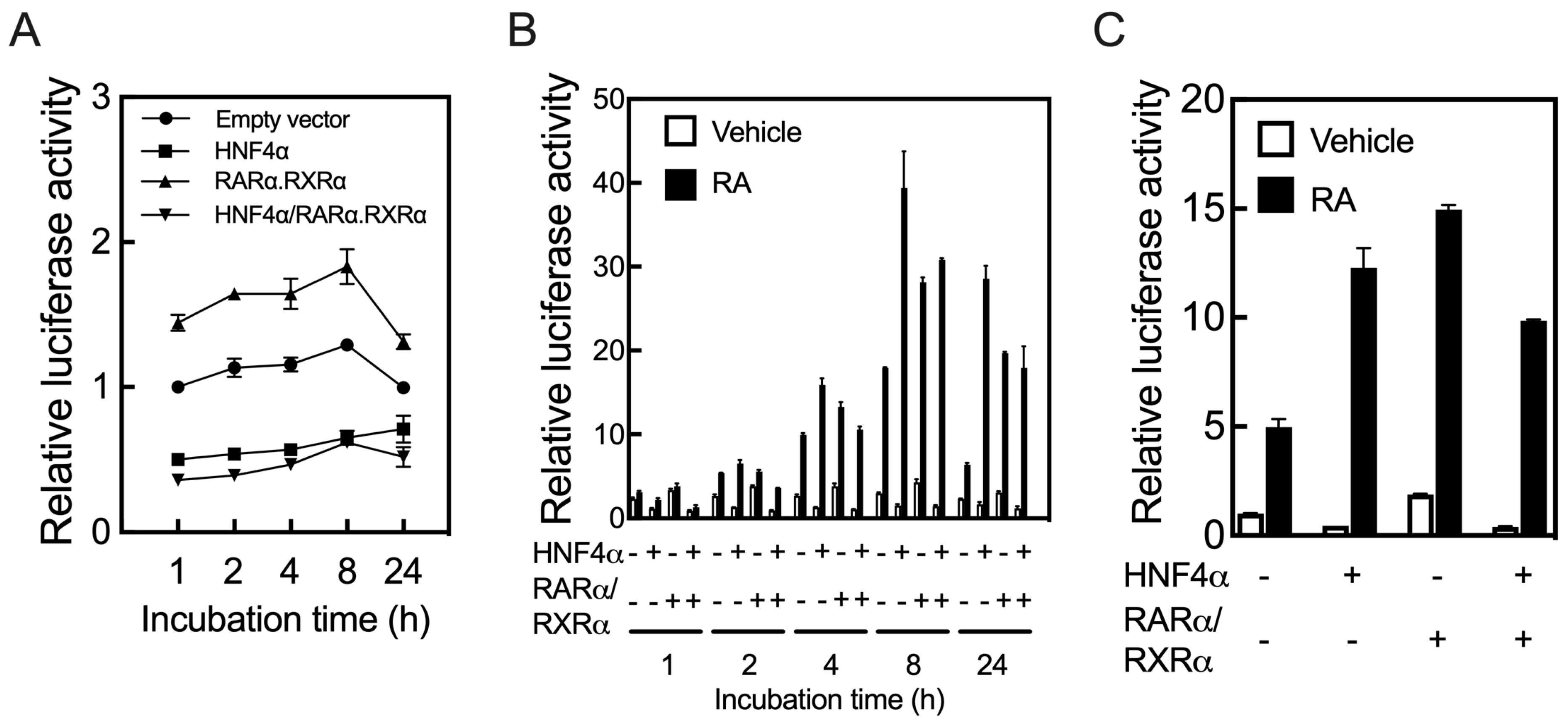
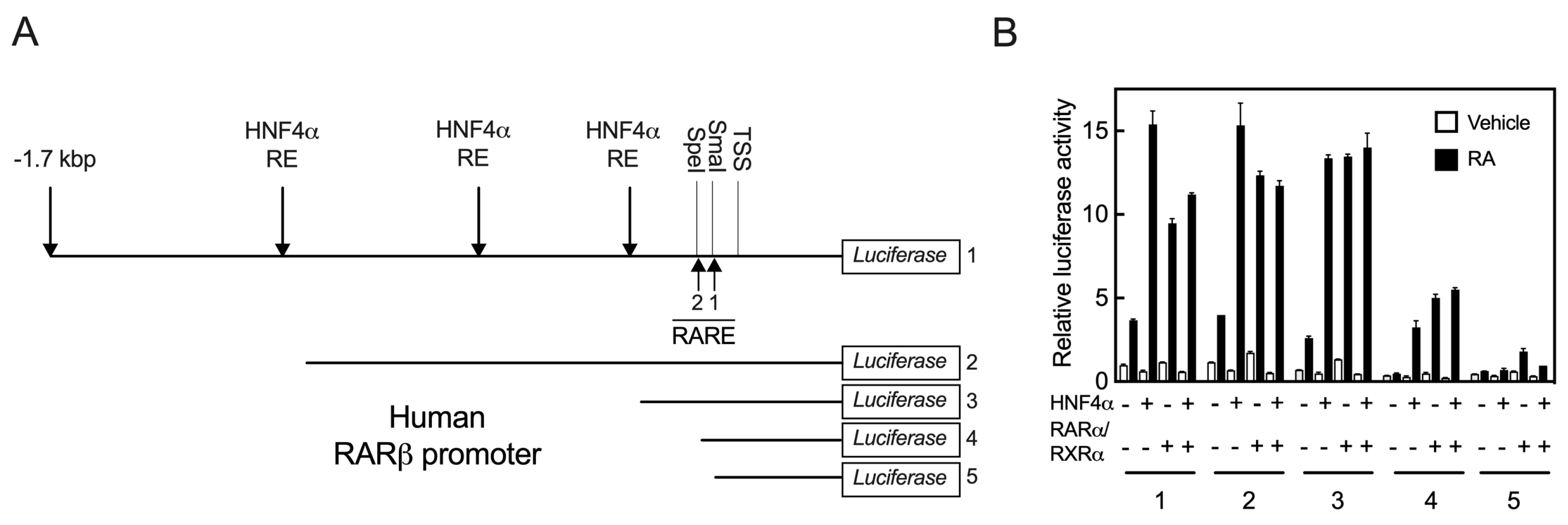

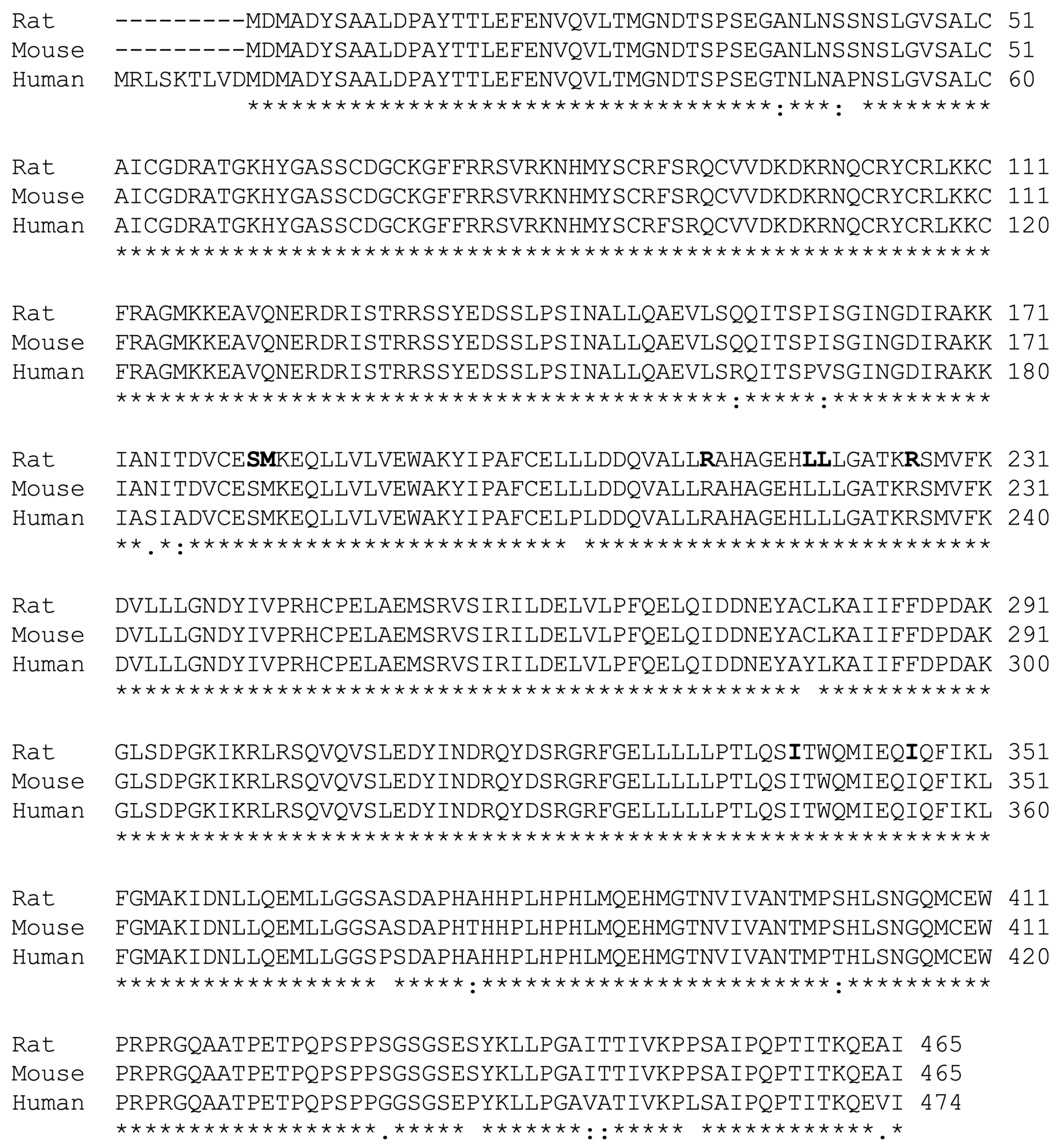
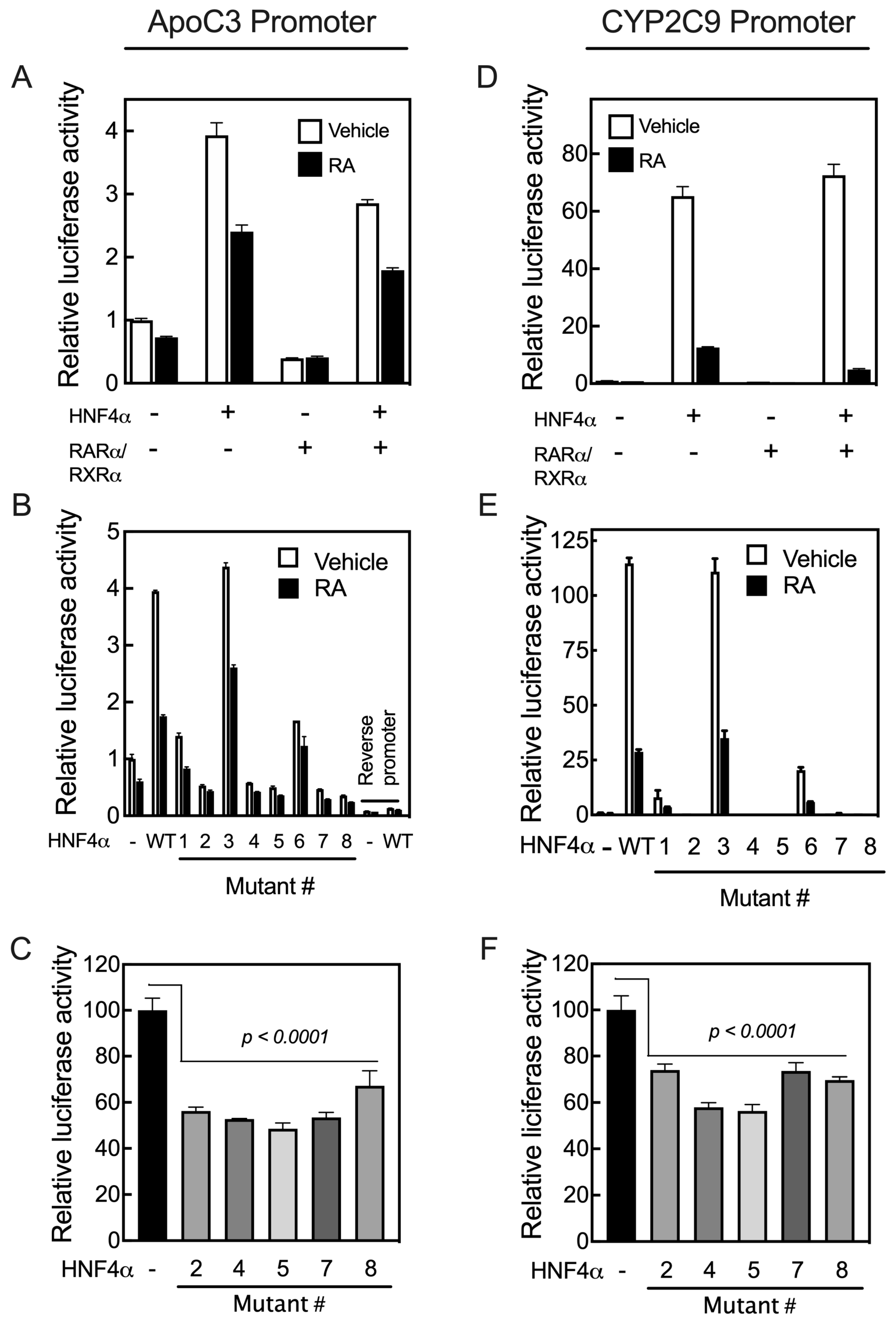
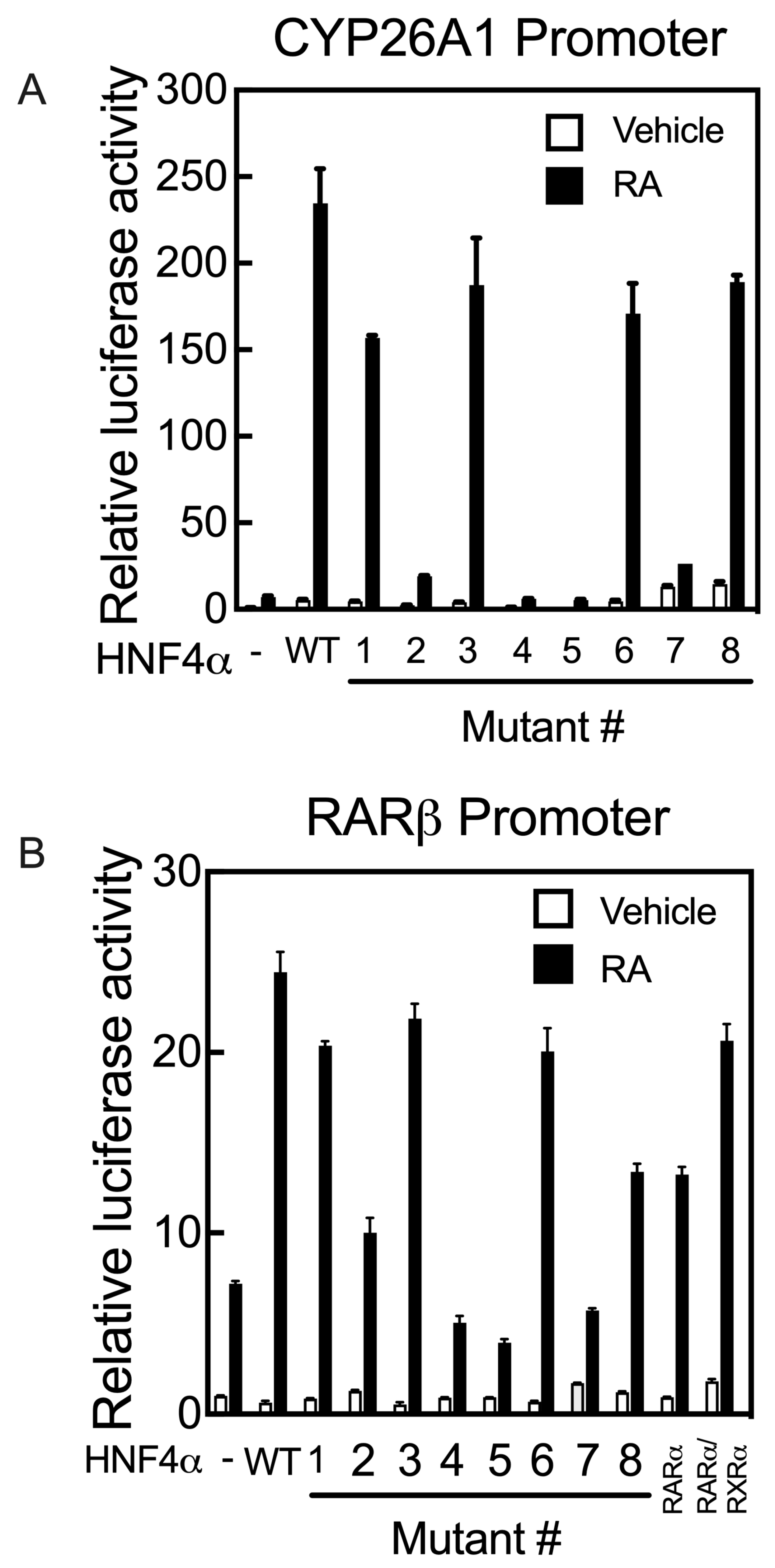
| Gene Name | Analysis | Primer Pairs |
|---|---|---|
| Mouse HNF4α | RT-PCR | S: ACATCCCGGCCTTCTTCTGCGAAC A: CATTGCCTAGGAGCAGCACGTCCT |
| Mouse ApoC3 | RT-PCR | S: ACATGGAACAAGCCTCCAAG A: GGAGGGGTGAAGACATGAGA |
| Mouse CYP26A1 | RT-PCR | S: TGCAGGCACTAAAACAATCG A: TCAATCGCAGGGTCTCCTTA |
| Mouse RARβ | RT-PCR | S: GCCTTCTCAGTGCCATCTGT A: CTGTTCTCCACTGAGCTGGG |
| Mouse RARβ | RT-PCR | S: CTTCCTCCTCCTCGGGTGTA A: GGCTTTGAGCAGGGTGATCT |
| Mouse RARβ | RT-PCR | S: TTCATGTTCGGGGCTGGG A: GGTAGCCCGATGACTTGTCC |
| 18S Ribosomal RNA | RT-PCR | S: CGCGGTTCTATTTTGTTGGT A: AGTCGGCATCGTTTATGGTC |
| Mouse RARβ promoter | Cloning | F: TAATTGGACAGGGGTGGTCT R: CGCTCTGCAAAAGTGCTTATC |
| Human ApoC3 promoter | Cloning | F: tgctagcCTTGGAGCCCTTAGAGCCTT R: tctcgagTACCTGGAGCAGCTGCCTC |
| Human RARβ mutant promoter | Cloning | F: ACTAGTTAATATATTTGATTATATGCAGCCCGGGTAGGGTTC R: GATCCCAAGTTCTCCTTCCA |
| Human RARβ mutant promoter | Cloning | F: ACTAGTTGGGTCACTAAGAGGTTAGCAGCCCGGGTAG R: ACTAGTGATTGATCCCAAG |
| Human RARβ deleted promoter | Cloning | F: TTCTAGTCACAGCTCTGAGC R: GATCCCAAGTTCTCCTTCCA |
| Human RARβ deleted promoter | Cloning | F: AAGCACTTCTTGTATTGTTT R: GATCCCAAGTTCTCCTTCCA |
| Mutant # | Mutant Residues | Primer Sequence |
|---|---|---|
| 1 | S190K | S: TTAAGCTTAAGGAGCAGCTGCTGGTTC A: TTAAGCTTCTCACACACATCTGCGATGC |
| 2 | M191K | S: TTAAGCTTGAGCAGCTGCTGGTTCTC A: TTAAGCTTGGACTCACACACATCTGCG |
| 3 | R221G | S: TTGGATCCCATGCTGGCGAGCACCTGC A: TTGGATCCGAGCAGGGCCACCTGGTCG |
| 4 | L228K | S: TTAAGCTTCTCGGAGCCACCAAGAGATC A: TTAAGCTTGTGCTCGCCAGCATGGGCTC |
| 5 | L229K | S: TTAAGCTTGGAGCCACCAAGAGATCC A: TTAAGCTTCAGGTGCTCGCCAGCATGG |
| 6 | R235G | S: TTGGATCCATGGTGTTCAAGGACG A: TTGGATCCCTTGGTGGCTCCGAGC |
| 7 | I347K | S: TTAAGCTTTGGCAGATGATCGAGCAG A: TTAAGCTTGCTCTGCAAGGTGGGCAGC |
| 8 | I355K | S: TTAAGCTTTTCATCAAGCTCTTCGGC A: TTAAGCTTCTGCTCGATCATCTGCCAG |
Disclaimer/Publisher’s Note: The statements, opinions and data contained in all publications are solely those of the individual author(s) and contributor(s) and not of MDPI and/or the editor(s). MDPI and/or the editor(s) disclaim responsibility for any injury to people or property resulting from any ideas, methods, instructions or products referred to in the content. |
© 2023 by the authors. Licensee MDPI, Basel, Switzerland. This article is an open access article distributed under the terms and conditions of the Creative Commons Attribution (CC BY) license (https://creativecommons.org/licenses/by/4.0/).
Share and Cite
Zolfaghari, R.; Bonzo, J.A.; Gonzalez, F.J.; Ross, A.C. Hepatocyte Nuclear Factor 4α (HNF4α) Plays a Controlling Role in Expression of the Retinoic Acid Receptor β (RARβ) Gene in Hepatocytes. Int. J. Mol. Sci. 2023, 24, 8608. https://doi.org/10.3390/ijms24108608
Zolfaghari R, Bonzo JA, Gonzalez FJ, Ross AC. Hepatocyte Nuclear Factor 4α (HNF4α) Plays a Controlling Role in Expression of the Retinoic Acid Receptor β (RARβ) Gene in Hepatocytes. International Journal of Molecular Sciences. 2023; 24(10):8608. https://doi.org/10.3390/ijms24108608
Chicago/Turabian StyleZolfaghari, Reza, Jessica A. Bonzo, Frank J. Gonzalez, and A. Catharine Ross. 2023. "Hepatocyte Nuclear Factor 4α (HNF4α) Plays a Controlling Role in Expression of the Retinoic Acid Receptor β (RARβ) Gene in Hepatocytes" International Journal of Molecular Sciences 24, no. 10: 8608. https://doi.org/10.3390/ijms24108608
APA StyleZolfaghari, R., Bonzo, J. A., Gonzalez, F. J., & Ross, A. C. (2023). Hepatocyte Nuclear Factor 4α (HNF4α) Plays a Controlling Role in Expression of the Retinoic Acid Receptor β (RARβ) Gene in Hepatocytes. International Journal of Molecular Sciences, 24(10), 8608. https://doi.org/10.3390/ijms24108608






